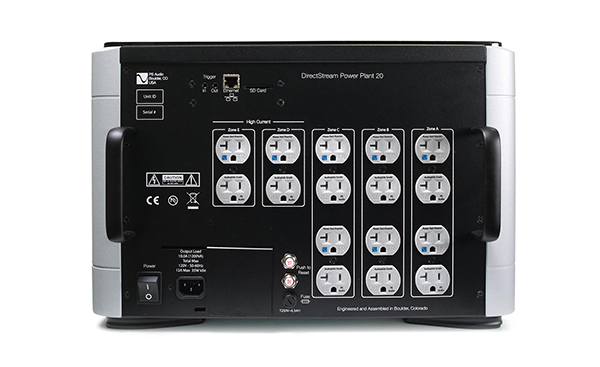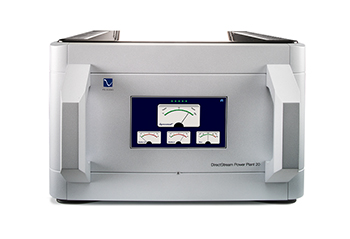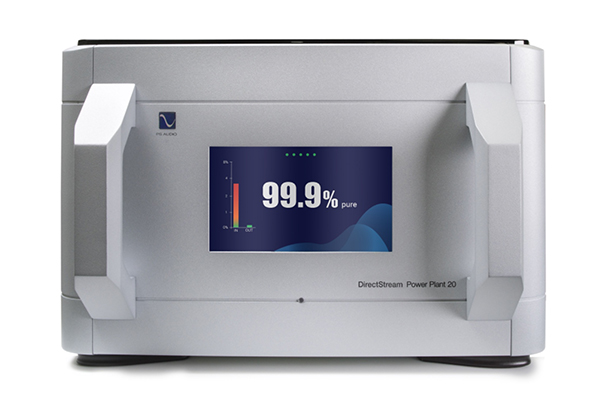The PS Audio P20 Power Plant Yeah, You Need One
By Jeff DorgayWhat’s a power conditioner review doing in discussion about analog? Considering how faint the signal coming from your phono cartridge is, anything you can do to keep that precious signal intact is a good thing. Many analog enthusiasts agree that the integrity of the source is paramount, so starting with a solid foundation is critical.
Some of the opinion that if their AC power has traveled many miles before getting to their audio system, a few more feet of wire for a premium power cord is just crazy talk. Equally opinionated, those from this group will usually squawk that their power is very clean. Cleaner than the power you and I get. The best kind of clean.
I disagree. Vehemently.
The power your system uses is like the fuel in an engine on one level, and more complex on another. If you subscribe to the approach that your amplifier is nothing more than modulating the AC signal with audio (a bit simplistic), then any distortion present in the power line will get amplified along with that audio signal. Massive power supplies are nearly always one of the keys to the performance that comes with a mega component.
Sure, your power supply probably goes a long way at getting rid of most of that grunge, but not all. If you’ve ever had the chance to look at the AC signal on a Fluke 435 power analyzer, you’d see just how much sheer distortion is in the AC line.
This is probably a lot geekier than any of you want to get, but inquiring minds need to know, and I must admit being shocked when examining what’s in that power line we plug our gear into. Depending on where you live, this can be better or worse, but rest assured, it’s there. And it can be made worse by other things in the immediate vicinity, on the same circuit as your house.
It’s often said that listening to your system provides better results. Indeed, some of this can be attributed to the psychoacoustic phenomenon of being more relaxed and receptive, but it’s easier than that – your next door neighbor probably isn’t running their appliances. Some of the culprits can easily be in your home as well. Power tools, vacuum cleaners, and even a microwave oven can send nasty artifacts back into the power line; all more distortion that taxes your amplifiers ability to deliver a clean signal.
So what to do?
Many power conditioning products use a series of filtration techniques to augment what your amplifiers’ power supply is trying to do. Some power conditioning products just use magic fairy dust, while even a few others don’t even require you to plug your amplifier in.
Years ago, PS Audio figured out a better way with their original Power Plant 300. It actually regenerated the AC signal from a stable oscillator and generated fresh AC power. It was a brilliant approach, but its only downfall was that it could only service a source component or two, not having enough reserve power for a power amplifier. It worked incredibly well and took things to a new level of clarity.
Today, the top of the line PS Audio P20, power regenerator does more. We’ll argue about the other systems later, somewhere on the internet. Right now, we just want to stress how important it is to get a PS Audio Power Plant into your system.
 The PS20 you see here can deliver somewhere between 1200VA and a full 2000VA to your system, depending on whether you have it plugged into a 15A line or have had a 20A line installed. Fortunately, with 15 and 20A receptacles in the PS20, it will sense the available power accordingly and deliver higher power if you have it. Both of my listening rooms have dedicated 20A lines, so this was easy to test.
The PS20 you see here can deliver somewhere between 1200VA and a full 2000VA to your system, depending on whether you have it plugged into a 15A line or have had a 20A line installed. Fortunately, with 15 and 20A receptacles in the PS20, it will sense the available power accordingly and deliver higher power if you have it. Both of my listening rooms have dedicated 20A lines, so this was easy to test.
Due to its massive capacity, the P20 has an MSRP of $9,995. It looks and feels like a giant power amplifier, which on one level it is. If you don’t have access to a 20 amp, dedicated line, save some green and pick up the P15, which has a maximum capacity of 1500 watts. The sonic effect is identical. Those with smaller systems may even be able to work with the 1000 watt capacity of the P12 for $4,995.
The result is unmistakable
Rather than wax poetic for thousands of words, the P20 works precisely as it should. It does no harm to the audio signal and expands the presentation in a few ways. As PS Audio says on their website, “it’s like being 50 feet from a power generating station.” But even the power station nearby still generates distortion in the AC process, no one built power plants with the thought of high-performance audio in mind.
As the P20 starts from scratch with an incredibly accurate DSD sine wave generator, and ultra-low distortion power amplifier (note those big heat sinks on the side of the enclosure) to generate new power with audiophile needs in mind. Thanks to the P20s sizeable current capability and low output impedance, your power amplifier can get all the current it needs, right now, so that musical peaks aren’t blurred, or worse, truncated. This is why some passive power line conditioners, even though they lower the noise floor, can rob your music of the essential dynamics – ultimately leading you to its removal once the honeymoon is over.
The P20 lets you have your cake and eat it too. Distortion goes way down – and you can see it by the front panel meters, which give you the option to see input and output distortion readings, as well as the quality of the AC waveform entering and exiting the P20.
Seriously, it only takes about 5 minutes to evaluate the P20, and a few more hours with a wide range of tracks to stop pinching yourself. Starting my evaluation with the fairly current heavy Pass Labs INT-60, plugging into the P20 was an instant epiphany. Fortunately, with a pair of 20 amp circuits and a 15 amp circuit near the equipment rack, it was a breeze to switch back and forth between P20 and the straight AC line.
It expands your audio universe
Instantly, playing the same tracks at the same volume, more dynamic range is immediately available. Thanks to the lower noise floor now available, digital sounds much more lifelike in its presentation, and an equal effect was observed with PS Audio’s DAC as well as the dCS and Gryphon DACs on hand for reference. Even the tiny PS Audio Sprout 100s sound was dramatically improved feeding it with the P20, but you’re probably not going to try that combination at home! The pristine power that the P20 delivers helps your audio system to disappear in the room better regardless of source.
The PS Audio P20 is an expensive upgrade to your hi-fi system, offering subtle and dramatic results at the same time. Nothing else you do to your system will have this effect. Before you start spending thousands of dollars on power cords, this will give you a clean foundation to build your system around, even in the context of a modest system. Though the cost appears high, I submit you won’t get this type of improvement elsewhere at anywhere near the price. And remember, there are the P15 and P10 for those with systems demanding less power.
 To PS Audios credit, they offer their in-home trial, so if you don’t find the P20 stunning, you can just send it back. They also have a tremendous trade-in program to help you dispose of what you were using, and have PayPal credit at their disposal, giving you 6-months interest-free financing.
To PS Audios credit, they offer their in-home trial, so if you don’t find the P20 stunning, you can just send it back. They also have a tremendous trade-in program to help you dispose of what you were using, and have PayPal credit at their disposal, giving you 6-months interest-free financing.
I’m gonna violate the prime directive and tell you to get one. You won’t be able to un-hear it, and you won’t be able to live without it. So be ready to pull the trigger when you take the test drive. Consider yourself warned. It’s that good.
The PS Audio P20 Power Regenerator
MSRP: $9,999
Peripherals
Analog Source Luxman PD-171D w/Kiseki Purple Heart
Digital Source PS Audio DirectStream DAC and Transport
Phonostage EAT E-Glo
Amplifier Pass Labs INT-60
Speakers Raidho XT-2 w/REL T7i Subwoofers
Cable Cardas Clear




